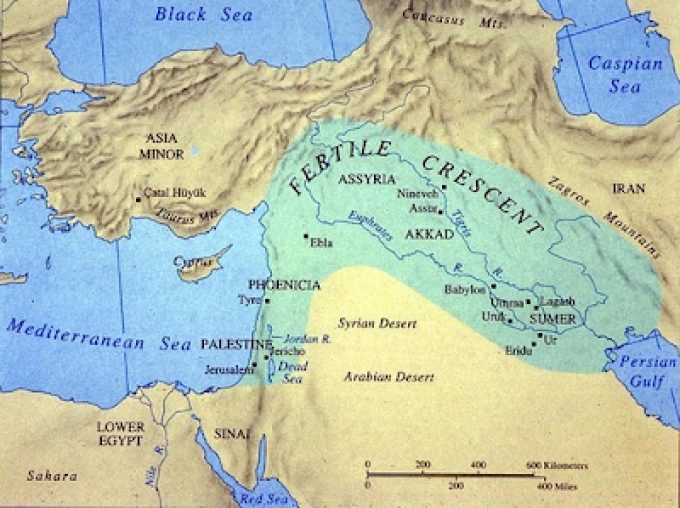Le antiche civiltà mediorientali antecedenti le favole bibliche…

La mitologia, la filosofia, la storia e le varie fedi, quanto hanno contribuito al rispetto per la Natura?
Per avere qualche nozione in merito alla religiosità della natura, bisognerebbe andare indietro nel tempo e precisamente all’epoca delle antiche civiltà con credenze politeiste, ossia più divinità simboliche interposte alla sacralità dei poteri inviolabili riconosciuti alla Natura.
Naturalmente questo concetto era radicato in Asia minore ed Europa, ma anche in altre aree, e diede vita a miti e leggende sorprendenti. Basti pensare alle civiltà dei Sumeri, Accadi, Assiri, i Babilonesi e tanti altri. Purtroppo con lo sradicamento della cultura definita “politeista”, che politeista in realtà non era poiché quelle antiche civiltà prendevano le forme degli dei come oggettivazioni della Natura, quello che restò nella storia è il mito dell’Arconte unico, il dio degli eserciti della Bibbia, fatto proprio anche dalle successive differenziazioni religiose cristiane e musulmane.
Secondo la bibbia la data della creazione è fissata al 3761 AC, e con questa “panzana” viene ignorato tutto ciò che è antecedente e matrice di civiltà.
In questo contesto di riscoperta di valori universali umani, che precedono le favole sui vari profeti e messia giudei (e successivamente cristiani e musulmani), emerge dalla tradizione Sumerica, nel terzo millennio a.C. (lo stesso periodo in cui per i giudei non era ancora stato creato il mondo), l’epopea di Gilgamesh, poi tramandata per centinaia di anni da molti popoli del Vicino Oriente scritta in caratteri cuneiformi su tavolette d’argilla (poi ritrovate a Ninive, l’antica capitale Assira durante alcuni scavi archeologici).
Oggi un certo tipo di revisionismo storico intende restituire il posto che merita a questo re di Uruk, campione dei valori umani e naturalistici. Gilgamesh è infatti il primo eroe storicamente certificato a partire in cerca di avventure, a uccidere mostri, sfidare gli dèi, viaggiare ai confini della terra deciso a conquistarsi con le sue gesta un nome imperituro e scoprire i misteri della vita. Infatti Gilgamesh affronta l’impresa suprema: la ricerca del segreto della vita eterna – un segreto che solo Utnapishtim, l’unico sopravvissuto al Diluvio Universale (altra storia rubacchiata dai giudei ed inserita nella bibbia), può insegnargli. Farà infine ritorno a Uruk ricco di una nuova consapevolezza: su questa terra la morte è il destino ineluttabile e nel godimento di questa esistenza risiede la saggezza. Da ciò si deduce anche da dove sorse la successiva filosofia greca dell’epicureismo.
Sulla matrice primigenia del pensiero religioso sviluppato nella terra dei Sumeri, e successivamente irradiato in tutto il medio oriente, esistono tutt’oggi parecchie interpretazioni. Il professor Alessandro De Angelis, noto antropologo e studioso antico testamentario, ha scritto: “Nei testi sumeri di circa 6000 anni fa si parla del dio EN.LIL, che aveva l’epiteto di ILU.KUR.GAL, ovvero “Signore della grande montagna”; egli aveva tre figli, uno dei quali si chiamava ISH.KUR o “Signore della montagna”, difatti il glifo KUR in sumero significa “montagna” mentre ISH è un gioco di parole che deriva dall’unire l’accadico ISHA (signore) con la desinenza cananea ISH (montagna), glifo che viene tradotto in accadico con SHADDU, e che si evolverà in ebraico in El Shaddai, dove El vuol dire “Signore”, mentre Shaddai significa “montagna”. Questo è l’epiteto con cui Dio si presenterà per la prima volta nell’Antico Testamento, quando in Genesi 17: 1,2 disse ad Abramo: «Io sono El Shaddai, cammina alla mia presenza e sii perfetto».
Ishkur prenderà il nome di Hadad in accadico, mentre per i cananei diventerà Baal Hadad. Gli Assiri cercarono di concretizzare il primo tentativo di monoteismo sul dio semitico Baal, tuttavia resosi conto che questo dio non era idoneo ad assurgere a tale funzione a causa della sua tradizione secolare, nonché dell’importanza che la sua figura ricopriva nel Pantheon cananeo, capirono che sarebbe stato arduo far traslitterare su di esso le caratteristiche di altre maggiori divinità. La soluzione per un passaggio dal politeismo al monoteismo fu trovata quindi facendo prendere in sposa al dio Baal la sua sorellastra Asherah, ed il figlio nato dalla loro unione fu chiamato Yaw El, dove possiamo subito notare l’assonanza con il dio biblico Yahweh. Fu così fatto traslitterare, questa volta con successo, il tentativo di monoteismo dal dio fenicio Baal a Yahweh, tanto che ritroviamo in entrambi lo stesso epiteto di Cavaliere delle nubi.”
Un altro studioso, Stefano Davidson, ha obiettato: “Tutte le religioni monoteiste provengono sì da una stessa origine ma questa era lo Zoroastrismo. Zarathustra nacque nei territori che adesso identifichiamo su per giù come Iran più di 3000 anni fa…”.
From other sources, however, different conclusions are drawn. According to current historiography, the Sumerians settled in southern Mesopotamia around 4,000 BC, but Indian sources anticipate that date to 5000 BC. (and even earlier) and trace the exodus to the period described in the Mahabarata, following the great war of Kurushetra, which should also correspond to the time of the sinking of the Sarashwati river in Punjab. of the city of Dwarka, the capital of Krishna submerged by the Indian ocean, and the mysterious destruction of Mohenjo Daro and Harappa (in Pakistan).
The Sumerians would be the survivors of the aforementioned cataclysms who took refuge by sea at the confluence of the Tigris and Euphrates. However it is certain that the Sumerians are of Aryan origin, as well as the Persians themselves, but the figure of Zoroaster (600 BC) comes long after the Sumerian civilization, in fact Zoroastrianism is a late reinterpretation of the Vedic religion.
In Bombay the Parsi community is still flourishing today, made up of descendants of Zoroastrian priests who fled from Persia, an island of Aryan culture and civilization, with the advent of Islam in that country. Ahura Mazda’s religion is based on the worship of sacred fire while funeral rites involve the display of corpses on tall towers to be devoured by birds. Air and fire are two of the five elements present in the Aryan sacral tradition and in fact the Iranian civilization is undoubtedly of Indo-European origin. The antiquity and the origin of this civilization are still being discussed, as there are several theories on its formation.
It is however certain that the so-called monotheism is centered on the figure of the male Archon, defined in the bible as Yahweh, who is the national god of the Jewish people and is the same father god of the trinity of Christianity (which is based precisely on Judaism) and the one God of the third Abrahamic religion, Islam.
But it is only after the period of the Babylonian exile (6th century BC) that Yahweh is certain to have been promoted to the sole god in the Jewish religion, definitively supplanting El (supreme god of the religions of the Near East) and assuming his attributes (including the epithets El Shaddai, “God Almighty”, and El Elyon, “God Most High”).
This male divinity is the patriarchal response to the previous Matristic religion, dedicated to Mother Nature, which had characterized all human society until the late Neolithic. The replacement occurred in conjunction with the recognition of the greater value of paternity as a “supporting” factor and consequently as a stimulating element for a new religion and mythology in a masculine key. But the process was slow, having to justify itself with substantial facts that guaranteed its acceptance by means of historical consequentiality and allegorical meanings. Even in the Jewish region, at the beginning, the cult of Yahweh seems to have been accompanied by that of Asherah, often considered the consort goddess of El in the Canaanite pantheon. In several more recent Israelite inscriptions, however, she appears to be believed to be Yahweh’s consort. In fact, thousands of clay statuettes, probably representing Asherah, have been unearthed and suggest that in reality the Israelites did not worship a single god in the monarchical age.
It must be considered that for the millennia before the patriarchy, women, as the primal incarnation of the procreative power of Nature, were worthy of love and devotion. Fatherhood was “ignored”, seen as a sort of accident, a marginal aid to the woman’s fertility. The mother certainly existed and this was an incontrovertible fact … How then the procreative operation happened was left to the maternal moods that were influenced or solicited by the love directed by the males towards the mothers. In short, the father was a simple inspiring element to promote motherhood, not a primary factor but an incidental help … But with the advent of the patriarchy everything changed and slowly, over the course of several centuries, the cancellation of the magnificent figure of Mother Nature took place. in favor of a male god and warrior.
Much later, but always in an area of Indo-European civilization, we even see that it is the male god who creates from himself. And this is what happens to Jupiter who, not helped by his wife, produces Minerva from his own brain. At this point, times have already changed, patriarchy now reigns supreme, women are only mares (or ether good to satisfy the desire of the male), even love, the true and noble one, manifests itself among males (see custom of all masters and warriors to have little boys for lovers). At that time the status of women had already somewhat expired and in Europe or the Middle East there were pockets of resistance only here and there (for example in Crete).
Malgrado la grande campagna ostracizzante verso il femminile e la Natura, nella tradizione giudaica la trasmissione della appartenenza al “popolo eletto” avveniva (ed è ancora oggi così) per via materna, ultimo rimasuglio matristico in mezzo a una serie di regole molto patriarcali e misogine. Tale misoginia fu assunta – in modi differenti – anche dalle altre due religioni monoteiste: il cristianesimo e l’islamismo.
Ma la lotta contro il Matrismo e la Natura e la verità storica in queste religioni prettamente maschiliste continua anche a livello di cancellazione dei reperti storici che potrebbero consentire la scoperta delle bugie e dei misfatti patriarcali. Ed ancora una volta sono i giudei a guidare la campagna di insabbiamento. Lo testimoniano i forsennati attacchi che ebbe a subire la spedizione archeologica italiana in Siria da parte dei sionisti. Quando il professor Paolo Matthiae scoprì il sito di Ebla e la “biblioteca” annessa, che nulla ha a che vedere con le superstizioni “bibliche”, ricorda questi attacchi e ricorda anche come venisse applicata la sordina alle puntuali risposte fornite dagli scienziati italiani alle, chiamiamole, obiezioni religiose. “Quando stavo a Gerusalemme mi hanno raccontato che sotto il cemento israeliano finirono pure gli scavi effettuati dagli svedesi davanti alla Porta di Giaffa poiché non corrispondevano alle fantasie religiose degli scritti considerati sacri. E lo stesso destino venne applicato non solo, come mi dicevano, agli scavi di Gerusalemme, ma ad ogni ritrovamento che non “corrisponde” a dette fantasie bibliche che ancora oggi sono trasformate in storia certificata da dio”.
Sulle antiche civiltà del Medio Oriente ci sarebbe ancora molto da raccontare, e lo faremo in puntate successive!





-ban.jpg)















































































































































































Non ci sono commenti, vuoi farlo tu?
Scrivi un commento